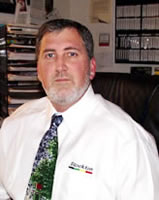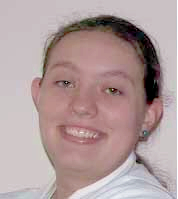Playing Hide and Seek with Mold: How an Infrared Thermographer and a Mold Inspector Can Partner in Their Search for Mold
Gregory R. Stockton
Stockton Infrared Thermographic Services, Inc.
8472 Adams Farm Road, Randleman, NC 27317
800-AIT-SCAN
Rachelle Dobbs
Dobbs Enterprises, Inc.
2945 Waumpi Trail, Maitland, FL 32751
407-629-4820
Abstract
The water damage from these hurricanes provided very good conditions for water intrusion, and in some cases, mold growth. Infrared thermographers and mold inspectors can be effective partners in quantifying damage and detecting mold, as long as both understand the advantages and limitations of their respective fields. The expertise of both is enhanced with microbial sampling, which scientifically establishes the presence of or absence of mold. Understanding construction, water intrusion and mold behavior all help in selecting the best location for obtaining accurate mold levels, remediating the mold and in repairing the damage.
Discussion
Mold is a Four-Letter Word
Mold is a microscopic fungus known to destroy building materials and cause health problems for many individuals. Molds help in the decomposition of dead organic materials. Mold is truly everywhere and is essential for life on earth; however, mold can become a problem in buildings when producing spores for reproduction, when breaking down building materials and when it grows in large quantities. Mold only needs four things in order to grow: a surface to grow on – practically any surface, a food source, moisture and time. Where conditions are right, mold can begin to grow and propagate in as little as 24 to 48 hours. There is no set standard for mold levels in buildings in the United States. The samples are evaluated by comparing the inside air to the outside air. The inside mold spore concentrations and species should be similar to those in the outdoor environment. Common spore counts, such as Penicillium/Aspergillus, Cladosporium, and Basidiospores, should be less than the outside air, and both indoor and outdoor samples should consist primarily of the same species. Mold spores that are rarely found outdoors, such as Stachybotrys or Chaetomium, should be nonexistent indoors. Their presence inside – even in relatively low numbers, is a clear indication that a mold problem exists.
To understand the basic life cycle of mold, a simple analogy with a dandelion can be made. Generally, dandelions have a root structure, a stalk and a seed releasing body at their top. Similarly, mold will have a stalk-like structure with a spore-releasing body at the end. Mold even has root-like structures, although they act more as a digestive lattice than the benign roots of a dandelion. As wind blows across a dandelion, it releases its seeds to propagate itself; so too with mold – the least amount of disturbance will cause the release of spores into the air. Some mold spores do not even need any breeze and just fall around the mold. When airborne spores land in a suitable environment, they start to germinate much like the seeds of a dandelion. The root-like structures of mold, called hyphae, then emerge, anchor themselves into the substrate, and secrete enzymes to help it rot, so that it can be absorbed. This cycle then repeats, ad infinitum.
There are three broad categories of mold:
-
Allergenic, which causes allergic or asthmatic reactions, but does not usually cause permanent health effects in most healthy, active people.
-
Pathogenic, which can cause serious health problems in those with suppressed immune systems.
-
Toxic, which can cause serious health problems in everyone.
Life Cycle of Mold (See Figure 1):
1. Mold spores come into a good environment
2. They germinate, and hyphae emerge from the spores and they start to grow
3. These hyphae secrete enzymes into the substrate to help it rot so that it can be absorbed
4. Mold creates spores for reproduction
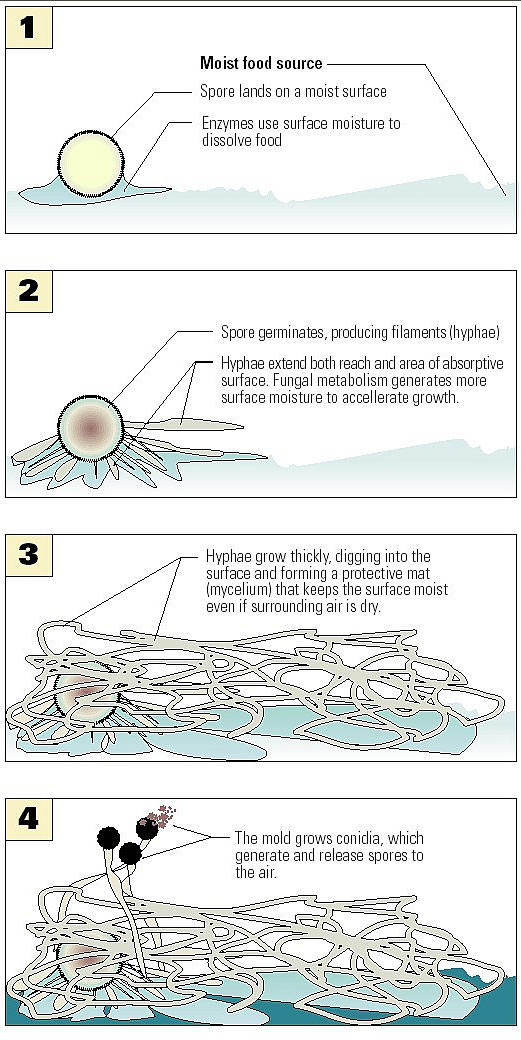
Water Intrusion and Moisture
We must differentiate between water intrusion and moisture in relation to mold and water damage. Water intrusion implies that the building has been compromised and water is coming from somewhere, either from the roof, the walls, the basement or from a mechanical or plumbing leak. Moisture inside the structure is a result of any one or a combination of factors, i.e., a water intrusion problem, a thermal envelope problem, a ventilation problem and/or an HVAC system problem. The swift action of the homeowner or building owner can make a huge difference after an event like a hurricane. Drying out the building should be done immediately because mold problems only compound with time. If mold has already settled in, using powerful fans to dry structures will only spread mold spores and cross-contaminate other areas of the building. Water vapor can increase moisture content in the building materials, thus encouraging mold growth. The faster the infrared thermographer performs the survey after the event, the more accurate the assessment will be in relation to water damage. Same with the mold inspection. The faster the mold inspector performs their assessment, the less severe the mold contamination will be.
Infrared Thermography Cannot Be Used To Detect Mold
IR thermography can be used to find moisture in building materials, see thermal and moisture envelope problems that can create the right conditions for mold growth in buildings, and to see if the active HVAC system is creating problems that can contribute to mold growth in buildings. In extreme cases, where the building materials are deteriorated to the point where the mass of the material is affected, IR can be used; however, a very sensitive IR imager and advanced IR techniques are usually required. Infrared thermographic surveys work well to find moisture in building materials when there is good thermal contrast due to the evaporative cooling effect and when temperature differentials are at their peak, but diminish as soon as the materials dry. Read these words and heed them: Infrared thermography cannot be used to detect mold. Mold does not exhibit an exothermic reaction that can be seen with an infrared camera walking around a building (see Figures 2a, 2b, 2c, 2d). Clear thermographic images of water intrusion and moisture problems were made possible shortly after the hurricanes, due to the moisture still being present on building surfaces. One big advantage is that large and inaccessible areas can be surveyed quickly and efficiently. Moisture problems in ceilings, which are not readily accessible with hand-held moisture meters, can be readily seen even with no stains present. Large areas of walls, windows and doors can be well-documented with infrared images. In a report, visual and infrared images are much more convincing than, say, “the moisture meter registered ‘red’ around the window.” The old adage “a picture is worth a thousand words” is true.
Infrared thermographers helped detect moisture in building materials and provided clients with a visual record of anomalies consistent with moisture intrusion, but as the months went by and building materials dried out, thermographic surveys were less useful and more difficult to perform. Infrared surveys are not effective when materials that were previously wet are dry, since there is no longer any temperature differential to detect. Some thermographers had to resort to ‘flood testing’ methods (wetting the walls with a water hose on the outside, while taking thermal images inside). One might believe that by locating moisture, mold can be located. This is not always the case. Here are a few scenarios that occurred shortly after the hurricanes:
Scenario 1
Water/moisture came from the roof onto the ceiling and ran down the inside of the walls and came out onto tile flooring. An infrared survey showed hardly any moisture on the ceiling. The homeowners had sponged up the water/moisture right away and used fans to dry out the wall. The building materials dried quickly, before mold had a chance to grow.
Scenario 2
Same conditions as above, except that the homeowners had carpeting and had not used a fan. Water/moisture in the carpet kept the environment damp for a long time and as a result the drywall wicked up water/moisture from the carpet and stayed moist long enough to allow mold to grow. Mold then grew on the back of the drywall and on the baseboard. Mold was also apparent from inside the room.
Scenario 3
Water/moisture came from the roof, ran along the side of a cathedral ceiling then down the inside of the wall. An infrared survey showed that the ceiling was wet as well at the bottom of the wall, but IR could not see the behind the walls, where the mold was growing. Also, the carpet kept the drywall moist and mold was found growing about two feet up from the bottom of the drywall.
Scenario 4
Water/moisture came from the roof onto the ceiling only and for some reason the water/moisture was able to pool. A water/moisture stain could be seen. An infrared survey showed that the ceiling was wet. Damp insulation kept the environment wet and mold started to grow on the ceiling and the blown-in insulation.
Mold detection is complex because mold can hide in the most inconspicuous of places and its behavior is sometimes unpredictable. Infrared thermography is a great tool to detect wet media. However, it has limitations in mold detection, mainly:
-
· If the medium was once wet and is now dry, no anomalies will be seen even though mold might have grown on the other side
-
If the wet area dries within 48 hours, the chances for mold to grow will be minimal
-
A wet spot may only be a wet spot. Water/moisture, taking the path of least resistance, may end up far away from the original source and mold may therefore grow far away from the point of the original moisture intrusion or on a surface
Pre-existing Condition
Some of the water damage and mold growth existed long before any hurricanes visited Florida this year. High relative humidity (RH > 80%) is common, as are badly designed, poorly constructed and poorly maintained buildings. Preventive/predictive maintenance in buildings is uncommon. First, all buildings should be kept dry during the construction process. Then, all buildings should be tested within a few months after construction or major renovations to the structure, the thermal envelope, the moisture envelope and/or the HVAC system as outlined below:
-
Measure the rate of ventilation and pressure (positive or negative) in the building. In many cases, damage to the building is caused by insufficient ventilation and/or an under- or over-designed HVAC system
-
Take mold samples from the air and the surfaces for microbial analysis
-
Monitor the structural integrity by using infrared thermography
-
Check the structure for air and water leaks using blower-door testing and IR thermography
Figure 2a) Visual image with no visible signs of mold
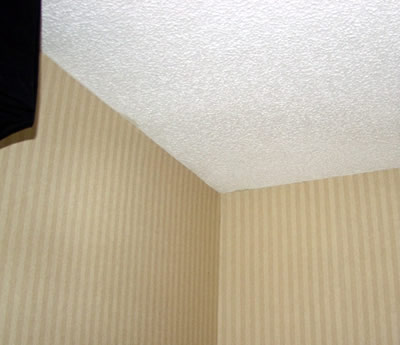
Figure 2b) Infrared image with no moisture indicated
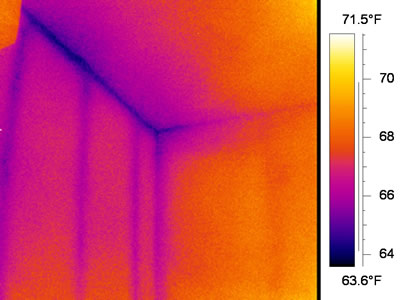
Figure 2c) Visual image with mold present

Figure 2d) Infrared image with wallpaper removed…
there are still no signs of moisture
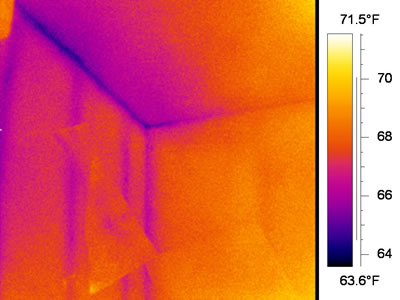
Mold Inspectors Detect Mold
Mold inspectors deal with the results of moisture in buildings, namely mold. They qualify and quantify the air quality in relation to mold. It is always easier to prove a positive – the presence of a mold problem, than to prove a negative – that there is no mold problem. An IR survey can reveal areas with a high probability of mold presence and narrow the search, which is a tremendous help. But even if moisture is not detected, the thermographer cannot guarantee that mold does not exist. Mold detection is not an exact science either. A distinction should be made here between a mold inspector and a mold remediator. They perform two entirely different functions. The remediator is a contractor, not a consultant, hired to clean mold from contaminated areas (and not to spread the mold to other parts of the building). Mold inspectors are more scientists/consultants, hired to assess the mold damage and recommend and specify remediation. In no instance should a remediator perform mold inspections or collect microbial samples, as this creates a conflict of interest. These are different fields of expertise and should be kept separate.
The way mold behaves sometimes baffles even the best of mold inspectors. Mold inspectors are faced with four basic scenarios when dealing with a known mold problem:
-
They know the source of water/moisture intrusion, but do not know the location of mold
-
They do not know the source of water/moisture intrusion, but can see mold
-
They do not know either the source of water/moisture intrusion or the location of mold
-
They know the source of water/moisture intrusion and the location of mold
Knowing the source of moisture in a building can help the inspector follow the trail to the mold colony. Infrared surveys are useful; however, sometimes no thermal signs of moisture or leaks can be seen. In this case, the mold inspector needs to work backwards from the visible mold to the water/moisture source, be it wet or previously wet, and now dry. In some cases, when the homeowner is getting sick and there are no visible signs of mold or water/moisture stains, the mold inspector needs to do some hard detective work.
When performing a mold survey, most mold inspectors use a moisture meter to test the walls for moisture. Whether there are visible signs of mold and/or moisture presence or not, the mold inspector should always collect microbial air samples to assess air quality. If a mold colony is present behind a wall, it releases spores into the air. These spores are like microscopic seeds that will usually (but not always) percolate through the semi-porous drywall into the room. With the help of a vacuum pump (see Figure 3), a precise volume of air is pumped through a canister (see Figure 4). The spores floating in the air will stick to a slide located inside the canister. An outside air sample is also collected as a control (baseline) and both are sent to an accredited laboratory.
Once in the lab, the microbiologist unseals both canisters and places the slides under a microscope for analysis. The species of mold are identified and the quantity of mold spores established for both samples. Then the microbiologist writes his report and shows a comparison between the mold spore levels found indoors and outdoors. With this information, the mold inspector learns whether there is a mold problem in a particular room. If the level of mold spores found inside the building is greater than or different than the levels found outside the building, the next step is to find out which exact area, wall, ceiling, or building component is contaminated. The mold inspector
must rely on the laboratory findings, but he/she must make sure that no other unusual conditions are present. Mold sampling is not as simple as setting up a pump apparatus in the middle of a room, pumping a precise volume of air into a canister, sending it to the laboratory and VOILA – you have the results.
Figure 3) Vacuum pump apparatus to collect air samples

Figure 4) Sample canister, etc.
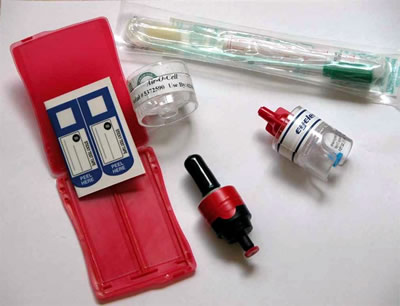
Figure 5) Collecting surface samples
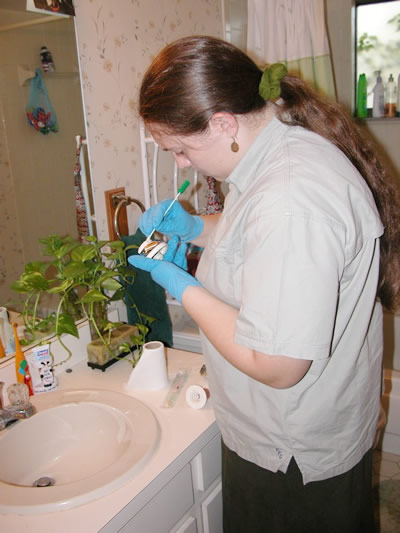
The following are factors that influence the accuracy of a mold sample:
-
For some reason, the mold is not sporing at the time of sampling
-
Some molds may be present but may take a long time before they spore
-
Some molds require an active disturbance in order to spore
-
A lack of air movement may prevent mold spores from going through the wall or ceiling into the ambient air of the room, where the sample is collected
-
Multiple independent sources of mold may be present
-
Large rooms with high cathedral ceilings can dilute the spore levels because of the large volume of air involved
The experienced mold inspector keeps all the above factors in mind during his/her investigation and when collecting mold samples. Like a detective working on a case, experience has taught him/her that only prudence and diligence will find mold wherever it may hide (see Figure 5). The amount of money that the building owner is willing to pay will create its own problem because it dictates how many samples the client is willing to purchase…the more samples that are taken, the greater the accuracy, but the greater the cost. From homeowners to corporate board members, the decision makers are not very well-informed consumers, often interested only in the bottom line – how much will it cost us? The competent inspector has to suggest an adequate number of samples without jeopardizing accuracy or losing the project in the bidding stage to a novice or unscrupulous competitor.
Time is of the Essence
Immediate action should be taken following water intrusion; first, to prevent any further water damage to the building by covering the affected structure (with tarps) and second, to minimize mold growth. Considering that mold can start growing within 24 to 48 hours after water intrusion, the sooner action is taken, the better. A simple thing, like removing all wet carpet immediately will greatly reduce the chance for mold contamination.
-
The proper way to protect a building and check for water/moisture damage and mold, specifically after an event like a hurricane, is shown below:
-
The building owner quickly assesses the damages and contacts his insurance company
-
The building owner hires a contractor to protect the building from further damage and has him remove all wet carpeting and building materials immediately
-
The infrared thermographer is hired to survey the building and produce a complete report with infrared and visual images and recommendations
-
Using the information from the IR thermographer, the mold inspector performs four main tasks: conduct a mold inspection, collect mold samples, evaluate and reconcile the laboratory findings/results with the mold survey, and write a protocol (if necessary):
-
The inspection helps document visible signs of mold-like substances and the ‘red flags’ that often lead to mold growth. The inspection, along with the IR images obtained from the thermographer, indicates the best location for sample collection
-
Samples are collected and sent to an accredited laboratory for analysis to determine if a mold problem exists, based upon the species and relative amounts of mold present
-
Laboratory results are evaluated to provide the client with a summary report reconciling the laboratory results with the mold survey to identify the area(s) with a mold problem
-
Write a protocol per the guidelines of the New York City Department of Health (or similar) to describe the scope of mold remediation and outline the steps to remove contaminated materials safely while protecting the occupants and workers·
-
-
A mold remediator will follow the safety precautions outlined in the protocol in removing the mold-contaminated medium while preventing the emission of fungi and dust contaminated with fungi from leaving the work area and entering an occupied or non-abatement area
-
48 hours after remediation is completed, the mold inspector will perform a post-remediation sampling to determine if all remediated areas are acceptable, both in terms of species and spores levels compared to conditions found outdoors
Conclusions
Infrared thermographers must recognize the limitation of infrared surveys in mold detection. It is always best to recommend that the client also hire an expert mold inspector. In all types of buildings, moisture information gathered by an infrared thermographer is extremely valuable to the mold inspector because it narrows down the search for mold, so long as the IR survey is performed quickly after the event. This saves the client time and money. Experts in both fields are needed – one dealing in moisture detection and the other in mold detection. The final objective is to help the client determine whether and where water damage has occurred and if so, whether there is a mold problem in the building. The cost of hiring both experts is minimal when the owner considers the preservation of structural integrity of the building and safeguarding the health of its occupants.
References
- Tracy, Dan. “City Looks To Tighten Rules for Builders” The Orlando Sentinel, 11 Nov. 2004, final edition: sec. A: 1, 8.
- Tracy, Dan, et al. “Home Builders are Told to Add Waterproofing” The Orlando Sentinel, 12 Nov. 2004, final edition: sec. B: 3.
- Harriman, Brundrett & Kittler. “Humidity Control Design Guide”, p. 102., ASHRAE, American Society of Heating, Refrigerating and Air Conditioning Engineers, Atlanta, GA, December 2001.
Advertisement

